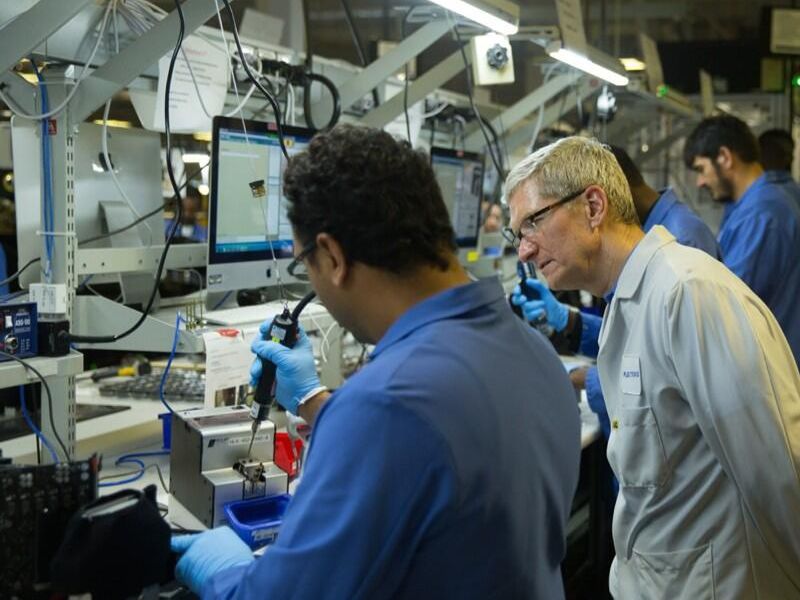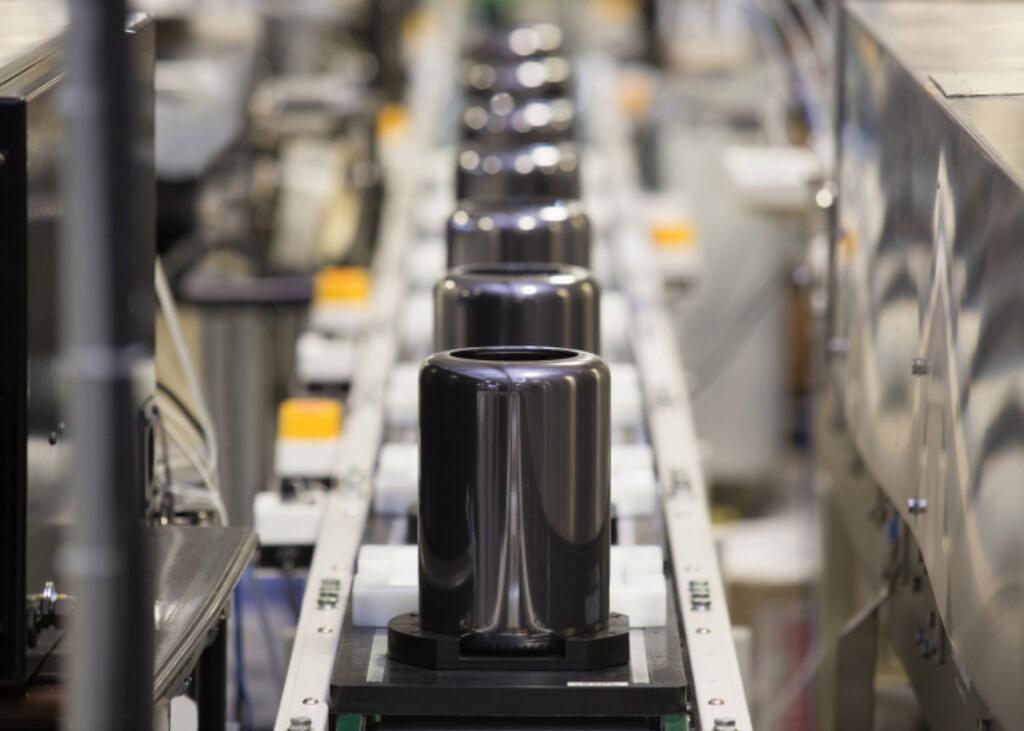New Mac Pros are coming. I had to pinch myself to prove I wasn’t dreaming.
February 19, 2019: New Mac Pro could be getting a 31.6-inch 6K3K display
Kuo Ming-Chi is back and not just with iPhone rumors this time. No, everyone’s favorite supply chain exfiltrator is also pushing Mac Pro and Pro Display rumors to go along with them.
Via 9to5Mac:
Additionally, Kuo adds that Apple will release a new Mac Pro with "easy to upgrade components" in 2019
Further, Kuo says Apple will return to the display market with a 31.6-inch 6k3k monitor. This display is said to feature a Mini LED-like backlight design, giving it "outstanding picture quality."
Now please.
April 5, 2018: Apple’s new Mac Pro won’t arrive before 2019
According to a new report from TechCrunch, Apple’s new Mac Pro will arrive sometime in 2019. It’s a ways off, but that doesn’t mean Apple isn’t working hard on delivering the pro product — in fact, it’s created a special team specifically tasked with design and development of the company’s pro products:
It’s called the Pro Workflow Team and they haven’t talked about it publicly before today. The group is under John Ternus and works closely with the engineering organization. The bays that I’m taken to later to chat about Final Cut Pro, for instance, are a few doors away from the engineers tasked with making it run great on Apple hardware.
What’s more, TechCrunch says Apple has hired creatives to put its pro products through their paces, discovering what works and what doesn’t. Apple uses this feedback to improve its products, both hardware and software, for the pro market. Be it iPad Pro, MacBook Pro, iMac Pro, or, well, anything Pro, it’s clear Apple is focusing on modularity in design and usability.
An iMac Pro with two iPad Pros hooked up to it allows for direct control, shortcuts and live access to the Logic manual all while you’re mixing a song on the main device. An eGPU with a MacBook Pro running a live edit of an 8K stream with color grading and effects applied.
It’ll be interesting to see how much this focus on modularity affects the final design of the Mac Pro. You can read more about Matthew Panzarino’s tour of Apple’s Pro Workflow team over on TechCrunch.
December 14, 2017: Apple still working on a the new Mac Pro and new Pro Display
As part of the company’s iMac Pro launch announcement, Apple also confirmed that it’s continuing to work on a new Mac Pro and new Pro Display.
From Apple:
In addition to the new iMac Pro, Apple is working on a completely redesigned, next-generation Mac Pro architected for pro customers who need the highest performance, high-throughput system in a modular, upgradeable design, as well as a new high-end pro display.
Still no word on the timing but hopes run high we’ll see the new Mac Pro and new Pro Display sometime in 2018.
Wow.
Apple recently broke with decades of tradition to spoil its upcoming product line to a select group of Apple-focused writers. And not just any product line: The company gave a sneak peek of its plans for the future of iMac — including a pro-focused high-end version — and, drumroll please: A new Mac Pro.
I’m going to repeat that, just so you all understand: A new Mac Pro. And new pro displays, branded by Apple.
This is pretty unusual for Apple, right?
Uh, yeah. In its 30+ years, Apple has rarely if ever broken its curtain of silence to publicly announce upcoming changes to its product line. The last instance I can think of was also pro-related news in nature: Apple did discuss upcoming updates to Final Cut Pro X after its initial reception wasn’t quite as warm as the company would have liked. But I can’t think of a time in my career covering the company where Apple executives — on record! — revealed product changes.
Why would Apple spoil new Macs?
As strange as this announcement may seem, it’s also long past due. The true pro market is a small one, but they’re also a passionate group feeling more and more left out in the cold by Apple’s aging 2013 Mac Pro. Pros need their computers for their livelihood as well as their enjoyment — and lacking a sign from Apple that the company was still invested in providing those machines, the community was very seriously considering moving away from Apple products.
Would losing this community matter for Apple’s bottom line? Probably not. As mentioned in Gruber’s fantastic interview with the Mac team on Daring Fireball:
Even among pro users, notebooks are by far the most popular Macs. In second place are iMacs. The Mac Pro is third. Apple declined to describe the Mac Pro’s share of all Macs sales any more specifically than "a single-digit percent", but my gut feeling is that the single digit is a lot closer to 1 than it is to 9.
That said, Apple has never been a company solely interested in monetary gains. Pro users were the company’s original backbone, and though the success of the iPhone has made them far less important to financial success than they once were, they still represent an important piece of the Apple community. After all: Many pro users are developers of Apple’s own software; without great developers, the Mac (and all of Apple’s platforms) wither.
In addition, pros support pro software: Not just by using and purchasing it, but by using it on the margins and bleeding edge. Professional users are what forces software like Final Cut Pro to evolve — where it’s then used by thousands of others who may not consider themselves true "pros":
Apple’s research shows that 15 percent of all Mac users use at least one "pro" app frequently. These are apps for things like music creation, video editing, graphic design, and software development. Basically, apps that are performance intensive. An additional 15 percent of Mac users use pro apps less frequently but at least once per week. That 30 percent of the overall Mac user base is what Apple considers the "pro" market.
30 percent of Mac users are probably unlikely to buy a new Mac Pro. But the five percent hiding within who will buy a new machine are the ones who help create the market for the other 25.
Why did Apple take so long to decide this?
It’s been too long. Apple, I think, realizes this. In their conversation with Gruber et al, executives acknowledged that the 2013 Mac Pro, while an achievement in innovation, wasn’t quite the machine that true professional users ended up needing. From senior vice president Craig Federighi:
I think we designed ourselves into a bit of a thermal corner, if you will. We designed a system with the kind of GPUs that at the time we thought we needed, and that we thought we could well serve with a two GPU architecture. That that was the thermal limit we needed, or the thermal capacity we needed. But workloads didn’t materialize to fit that as broadly as we hoped.
Being able to put larger single GPUs required a different system architecture and more thermal capacity than that system was designed to accommodate. So it became fairly difficult to adjust. At the same time, so many of our customers were moving to iMac that we saw a path to address many, many more of those that were finding themselves limited by a Mac Pro through next generation iMac. And really put a lot of our energy behind that.
It’s hard to say when this lightbulb moment happened internally at Apple, but we can estimate: I wouldn’t be surprised if discussions started to emerge in 2014, given the 2015 and 2016 releases of the higher-end 5K 27-inch iMac and 4K 21-inch iMac.
But as Federighi points out, rethinking the Mac Pro was going to take time. Nicer iMacs were good stopgaps, but in the meantime, the 2013 Mac Pro sat, aging and unloved. It’s a logic problem: Do you waste the manpower to give a system incremental updates that you know you no longer want to support, or focus on fixing the overall problem?
I do almost wonder if Apple toyed with the idea of just replacing the Pro line outright with better and better iMacs at one point — the new iMac line certainly seems to suggest that the company is interested in filling more pro needs with a less complicated computer.
But outcry from the professional community captured Apple’s attention — enough to make them break with decades of secrecy. It was undoubtedly a hard call to make inside Apple’s executive team, but I’m glad they finally did it.
So what’s coming for the Mac Pro?
A new, modular model along with a new Apple-designed display (likely 5K, though Pike’s Universum claims that there may be an 8K model in the works). The current 2013-era Mac Pro also got a small speed bump to tide people over.
Tell me about the speed bump for the 2013 Mac Pros? Is it worth upgrading?
It’s a pretty meager update, but at the least upgrades the aging Pro to something somewhat resembling a modern pro machine.
- The baseline $2999 Mac Pro sees an increase to 6 Xeon CPU cores (from 4), and switches to dual AMD D500 GPUs (from D300).
- The $3999 Mac Pro gets 8 Xeon CPU cores (from 6), and upgrades the GPU to an AMD dual D700 (from dual D500).
Of course, because there aren’t any updates to the computer’s ports, you won’t be able to run any USB-C or Thunderbolt 3 devices (including LG and others’ 5K displays).
Knowing that new Mac Pros are coming, I wouldn’t purchase this computer as a professional user unless it was absolutely necessary that I have a short term speed increase in my everyday workflow.
When is the new Mac Pro coming out?
They’re currently in the development pipeline — sadly, there’s no specific target date given, only "not this year".
From senior vice president of worldwide marketing Phil Schiller:
With regards to the Mac Pro, we are in the process of what we call "completely rethinking the Mac Pro". We’re working on it. We have a team working hard on it right now, and we want to architect it so that we can keep it fresh with regular improvements, and we’re committed to making it our highest-end, high-throughput desktop system, designed for our demanding pro customers.
Better still, the plan is to return the pro desktop line to its modular origins. This means that pro users will be able to swap out graphics cards, hard drives, and the like to fully customize and upgrade their machine after purchase. Now, knowing Apple, "fully customize" may be a stretch — but I imagine the new Mac Pro will be much friendlier to upgraders and graphics cards afficianados than its fully-enclosed 2013 predecessor.
OS News sources claim that the decision to create a modular Mac was relatively recent — only "a few weeks ago," though that contradicts what we’ve personally heard.
Will the new Mac Pro support VR?
To be determined, but it was specifically highlighted in the chat:
For examples of the type of software that the current Mac Pro isn’t well-suited for, Federighi mentioned VR: "Those can be in VR, those can be in certain kinds of high end cinema production tasks where most of the software out there that’s been written to target those doesn’t know how to balance itself well across multiple GPUs, but can scale across a single large GPU."
Patently Apple has also noticed that Apple has updated its Mac Pro trademark to include a mention about "augmented reality displays," though the update doesn’t refer to a specific product.
What about the new Apple display?
Yes! The LG partnership appears to only be part of Apple’s long-term display plans, and as part of the eventual Mac Pro overhaul, Apple plans to release a new display, too. From senior vice president of worldwide marketing Phil Schiller:
As part of doing a new Mac Pro — it is, by definition, a modular system — we will be doing a pro display as well. Now you won’t see any of those products this year; we’re in the process of that. We think it’s really important to create something great for our pro customers who want a Mac Pro modular system, and that’ll take longer than this year to do.
As for the specs of this unknown dispaly, we can only speculate (ha ha), but it’s highly likely we’ll see a Retina display of at least 5K, if not more. (Pike’s Universum claims that there may be an 8K model in the works.)
Anything on pro software like Final Cut and Logic?
Yes! Though the interview wasn’t geared toward software, Schiller did note:
Both with Final Cut Pro 10 and Logic 10, there are teams on those software products that are completely dedicated to delivering great pro software to our customers. No foot off the gas there.
Gruber also asked about scripting and automation — especially interesting given Apple’s recent acquisition of automator app Workflow:
I asked about scripting and automation — whether Apple still sees scripting and automation as an important part of the pro market. Federighi: "We think scriptability and automation of the system remain super important."
Anything else of note about the upcoming Mac Pro?
I leave you with John Gruber of Daring Fireball’s excellent interview with the Mac team and overall analysis of the situation. Read it.
Still want more? Read the reports from the other writers at the roundtable, including a full transcript of the interview:









Recent Comments